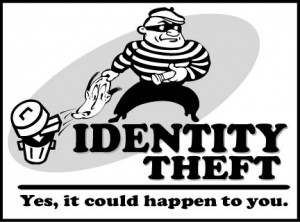Identity Fraud: It Happened to Me!
As I tackled my tax return last night (procrastinate much?) I was in for quite the shock.
When reviewing my bank account statement, I saw that three days ago a $2,000 payment was made from my Wells Fargo checking account to a “John Doe” (pseudo-name has been changed to protect the guilty) via PayPal.
Shut The Front Door- I did not authorize that payment!
 image source.
image source.
How the heck did this happen to me? After all, I spend hours every week advising other people how to prevent identity theft.
First stop – my wallet. There was my check card, in my possession right where I last left it. Yet, some jerk is withdrawing funds from my checking account. What gives?
- Stolen purse? NO. It’s right where it should be…
- Stolen mail? NO. Duh, I have a Mail Boss!
- Stolen trash? NO. I have a fireplace!
That covers the most common ways thieves steal personal information, but of course there are dozens of other ways too. I’ve even published articles on this very topic.
I could have been the unsuspecting victim of:
- A corporate data breach
- Card skimming
- Wireless card reading
- Shoulder surfing
- Hacking
- and so on…
So What Did I Do?
(What you should do if this happens to you)
1. Immediately contact your bank.
I called Wells Fargo right away to let them know about the fraudulent charge. This initiated a fraud investigation that, once completed, should result in the stolen funds being returned.
2. Close your compromised account.
The bank may tell you this is unnecessary, but when your account is breached and your card is still in your possession, getting a new card is not adequate. Insist on getting a new account number. This is a huge pain, but it is worth it, since someone probably has your bank account information.
3. Issue a fraud alert with the Credit Bureaus.
I contacted Experian, but you can contact any of the three credit bureaus to issue a fraud alert, since they all ‘talk’ to each other. A fraud alert with one will apply to all three. This is FREE but expires after 6 months. Essentially, identity theft protection companies such as LifeLock ensure that a fraud alert is perpetually active with the credit bureaus. You can call after 6 months to renew the alert if necessary.
Lessons Learned
I am super paranoid about identity theft – it’s an occupational hazard. I take all the right precautions to protect myself:
- Secure my mail with a quality locking mailbox
- Destroy – don’t trash – sensitive mail
- Never open suspicious phishing emails
- Refuse balance transfer courtesy checks
- Review bank account statements regularly
And yet, some scammer still managed to steal my personal information for identity fraud.
The fact is, I will likely never know how this happened.
So here I am, in the great majority of identity theft victims who do not know how their information was compromised!
I guess it was bound to happen, eventually. After all, there are over 10 million victims of ID theft in the US every year. Like I always say, it’s not a matter of if, but when!
I just wasn’t really talking about me.
I guess the take home message here is that anyone can fall victim to identity theft. The best you can do is take the necessary precautions to protect yourself, and take the necessary actions if – despite your best efforts – your information does happen to fall in the wrong hands.
And don’t feel bad if someone manages to steal your identity and you have no idea how…
… you’re in good company! 🙂


Great information 🙂